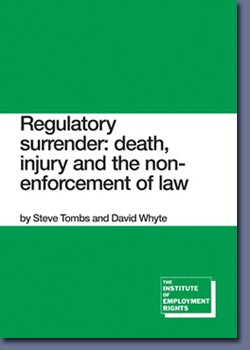CWU Argues Latest Statistics Show Need For Better Health And Safety Culture
 Dave Joyce, CWU's
National Health, Safety & Environment Officer, letter to branches issued this week quotes current health and safety statistics detailing the number of deaths, injuries and workers made ill by their work as furtehr proof that the UK needs better health and safety, not less as proposed by the Tory/LibDem Coalition Government:
Dave Joyce, CWU's
National Health, Safety & Environment Officer, letter to branches issued this week quotes current health and safety statistics detailing the number of deaths, injuries and workers made ill by their work as furtehr proof that the UK needs better health and safety, not less as proposed by the Tory/LibDem Coalition Government:
In LTB640/10, Dave quotes some of the main stats from the Institution of Occupational Safety and Health (IOSH) study statistics relating to ill health:
* In 2008/09 an estimated 1.2 million people, who worked in the last twelve months suffered from ill health which they thought was work related (Labour Force Survey (LFS)
* Musculoskeletal disorders are the most common type of work-related illness but mental ill health gives rise to more working days lost.
*
Figures for the last three years show that a yearly average of around 5500 cases were assessed for industrial injuries disablement benefit (IIDB). The largest categories were vibration white finger, carpal tunnel syndrome and respiratory diseases associated with past exposures to substances such as asbestos and coal dust
*
The annual number of work related cancer deaths is likely to be more than 8000
*
About 4000 cancer deaths each year are due to past exposure to asbestos
* In 2007 there were 96 deaths from asbestosis (as underlying cause), and 156 from other types of pneumoconiosis, mostly due to coal dust and silica.
* Around 15% of chronic obstructive pulmonary disease (COPD – including bronchitis and emphysema) may be work related. This suggests there could be some 4000 COPD deaths each year due to past occupational exposures to fumes, chemicals and dusts.
* The annual number of mesothelioma deaths has increased from 153, in 1968, to 2056, in 2007
The figures for workplace deaths and injury are also quoted and make grim reading:
* 413 people have died in the workplace over the last two years
* Around 1000 workers die in work related road traffic accidents each year.
* 131,895 employees were injured in 2008/09 ( as reported under the Reporting of Injuries, Diseases and Dangerous Occurrences Regulations (RIDDOR)
* There were 27 594 major injuries to employees reported in 2008/09. Over one third were caused by slipping or tripping
* There were 104 301 other injuries to employees causing absence from work of more than 3 days. Around two fifths were caused by handling, lifting or carrying, and a quarter due to slipping or tripping
* Deaths in the workplace – 2008/09
Agriculture: 26 (5.7 deaths per 100 000 workers)
Construction: 53 (2.4 deaths per 100 000 workers)
Manufacturing: 32 (1.1 deaths per 100 000 workers)
Services: 63 (0.3 deaths per 100 000 workers)
The cost to the community in terms of working days lost:
* 29.3 million working days were lost in 2008/09, 24.6 million due to work-related ill health and 4.7 million due to workplace injury
As the CWU knows, this does not give the complete picture as it has long been known that the HSE officials figures do not accurately reflect the complete picture and relies solely on incidents reported by the employer in the case of workpalce deaths or injuries resulting in more than 3 working days lost to sickness from ill health caused by work.
 Professor Steve Tombs and Dr Dave Whyte have researched workplace deaths and injuries. In their new book, published this month entitled, Regulatory Surrender: death, injury and the non-enforcement of law, launched at The Institute of Employment Rights conference held in Liverpool early July; they analyse recent enforcement data.
Professor Steve Tombs and Dr Dave Whyte have researched workplace deaths and injuries. In their new book, published this month entitled, Regulatory Surrender: death, injury and the non-enforcement of law, launched at The Institute of Employment Rights conference held in Liverpool early July; they analyse recent enforcement data.
They accuse the HSE of being in crisis and provided further evidence of a lack of the existing health and safety law being fulled applied in this country.
Their booklet states:
" Using a combination of published data and data obtained through a
series of Freedom of Information requests, this report charts how
regulatory enforcement has been repositioned to accommodate neoliberal,
business-friendly values. In combination, the available data
indicates that something rather dramatic took place with regards to
HSE enforcement practices in the past decade. Specifically, it
indicates:
* a rapid decline in HSE enforcement action generally is apparent
from 2002/03, and in particular, the most recent sharp decline in
prosecutions begins in 2003/04
* a collapse in RIDDOR prosecutions which appears to begin in
2002103
* some indications that the collapse in prosecutions is replaced to
some extent by a rise in enforcement from around 2004/05,
although enforcement notices remain at a significantly lower level
than in the early years of Labour's first period in office. "
Source: CWU / IER / S Tombs & D Whyte